Complete Solutions to LEVEL - 2 of chapter GENERAL ORGANIC CHEMISTRY of Class 12 book with complete answers and questions
| Class 12 | CHEMISTRY |
| Chapter | GENERAL ORGANIC CHEMISTRY |
| MS CHOUHAN | LEVEL - 2 |
| Number Of Questions | 95 |
| Academic Year | 2023-24 |
Rank in order of radical stability (1 = most stable).

View SolutionPredict the acidity order for the three phenols shown below :
Acidity order : 1 (most) to 3 (least)

Acidity order: ……….. ……….. ………….
View Solution
Which of the phenol derivatives above is the strongest acid ?
`square` Compound A `" "square` Compound B `" "square` Compound C
`square` Compound D `" "square` Compound E `" "square` Compound F
View Solution
Which of the phenol derivatives above is the weakest acid ?
`square` Compound A `" "square` Compound B `" "square` Compound C
`square` Compound D `" "square` Compound E `" "square` Compound F
View Solution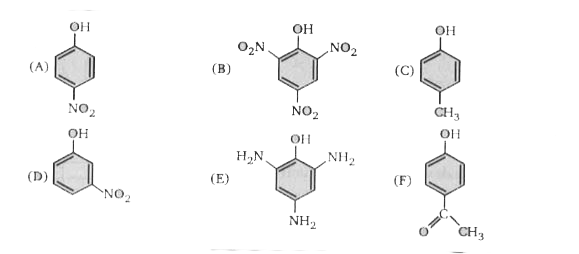
Which of the mono-nitrophenol derivatives above is the strongest acid ?
`square` Compound A `" "square` Compound D
View Solution
Which of the carbon-substituted phenol derivatives above is the strongest acid ?
View SolutionThe following questions refer to the twelve compounds given below. You may enter as many as six choices in each answer box.

Which compound may serve only as H-bond donors ?
View SolutionThe following questions refer to the twelve compounds given below. You may enter as many as six choices in each answer box.

Which may serve both as H-bond donors and acceptors?
View SolutionThe following questions refer to the twelve compounds given below. You may enter as many as six choices in each answer box.

Which compounds will not participate in H-bonding ?
View SolutionConsider the following compounds and answer A and B.

Which of the compounds is the strongest Bronsted acid ?
View Solution
Which of the compounds is the strongest Lewis base ?
View SolutionRank the non-bonding electrons indicated by the arrows in order of increasing energy.

View SolutionIn each of the following sections four nitrogen containing compounds are listed. In the box under each formula write a number (1 to 4) indicating the order of base strength.

View SolutionFor the two sets of acids shown below, rank their acidity most acidic to least acidic.

View Solutionrank their acidity most acidic to least acidic.

View SolutionIn each of the following sections four compounds are listed. In the box under each formula enter a number (1 to 4) indicating the order of acid strength (1 is strongest & 4 is weakest).

View SolutionIn the two questions below, you are asked to rank the relative strengths of illustrated acids and bases. Use your knowledge of resonance and inductive to answer this.
For the series of bases shown below, rank the set from strongest to weakest.

View SolutionIn the two questions below, you are asked to rank the relative strengths of illustrated acids and bases. Use your knowledge of resonance and inductive to answer this.
For the series of acids shown below, rank the set from strongest to weakest.

View SolutionIn each of the following sections four compounds are listed. (Decreasing order of acidic strength, 1 is strongest & 4 is weakest).


View SolutionRank in the order of increasing basic strength.

View SolutionCompare acidic strength of the following (Write your answer in box).


View SolutionArrange the hydrogens in increasing order of their acidic strengths.

View SolutionThe compounds whose structures are shown below, incorporate a variety of functional groups. The question on the right ask you to identify which compounds have a specific functional group. For each compound that has the designed group, enter the appropriate number. The aromatic rings should not be counted as double bonds.

Which have carbon-carbon double bonds ?
View SolutionThe compounds whose structures are shown below, incorporate a variety of functional groups. The question on the right ask you to identify which compounds have a specific functional group. For each compound that has the designed group, enter the appropriate number. The aromatic rings should not be counted as double bonds.
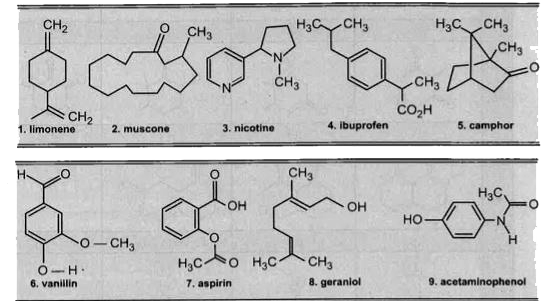
Which have a ketone carbonyl group ?
View SolutionThe compounds whose structures are shown below, incorporate a variety of functional groups. The question on the right ask you to identify which compounds have a specific functional group. For each compound that has the designed group, enter the appropriate number. The aromatic rings should not be counted as double bonds.

Which have an aldehyde carbonyl group?
View SolutionThe compounds whose structures are shown below, incorporate a variety of functional groups. The question on the right ask you to identify which compounds have a specific functional group. For each compound that has the designed group, enter the appropriate number. The aromatic rings should not be counted as double bonds.
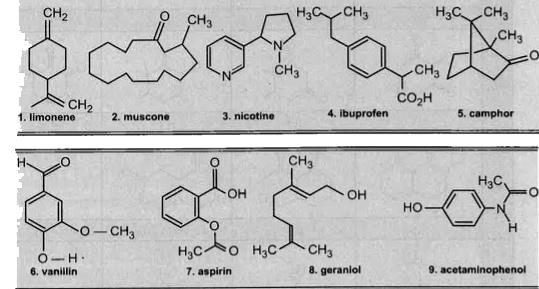
Which have aromatic rings ?
View SolutionThe compounds whose structures are shown below, incorporate a variety of functional groups. The question on the right ask you to identify which compounds have a specific functional group. For each compound that has the designed group, enter the appropriate number. The aromatic rings should not be counted as double bonds.

Which have a hydroxy group ?
View SolutionThe compounds whose structures are shown below, incorporate a variety of functional groups. The question on the right ask you to identify which compounds have a specific functional group. For each compound that has the designed group, enter the appropriate number. The aromatic rings should not be counted as double bonds.

Which have ether groups ?
View SolutionThe compounds whose structures are shown below, incorporate a variety of functional groups. The question on the right ask you to identify which compounds have a specific functional group. For each compound that has the designed group, enter the appropriate number. The aromatic rings should not be counted as double bonds.

Which have an ester group?
View SolutionThe compounds whose structures are shown below, incorporate a variety of functional groups. The question on the right ask you to identify which compounds have a specific functional group. For each compound that has the designed group, enter the appropriate number. The aromatic rings should not be counted as double bonds.

Which have an amide group?
View SolutionThe compounds whose structures are shown below, incorporate a variety of functional groups. The question on the right ask you to identify which compounds have a specific functional group. For each compound that has the designed group, enter the appropriate number. The aromatic rings should not be counted as double bonds.

Which have a carboxylic acid group ?
View Solution
Which is the strongest acid in 1?
View Solution
Which is weakest acid in 1 ?
View Solution
Which is the strongest acid in 2 ?
View Solution
Which is weakest acid in 2 ?
View Solution
Which is the strongest acid in 3 ?
View Solution
Which is weakest acid in 3 ?
View Solution
Which is the strongest acid in 4 ?
View Solution
Which is weakest acid in 4 ?
View SolutionFor each of the six structural formulae (A through F), shown below, five questions are posed. The answer to each is a number that should be entered in the appropriate answer box.

`{:(A,"(i)Number of" sp^3 "carbons:",B.,"Number of"sp^3,C.,"Number of"sp^3),(," ..........",,"carbons:"..........,,"carbons:"..........),(,"(ii)Number of" sp^2 "carbons:",,"Number of "sp^2"carbons:",,"Number of "sp^2"carbons:"),(," ...........",, ..........,, ...........),(,"(iii) Number of sp carbons:",,"Number of sp carbons:",,"Number of sp carbons:"),(," ...........",, ..........,, ...........),(,(iv)"Number of carbon - carbon",,"Number of carbon - carbon",,"Number of carbon - carbon"),(," "sigma- "bonds:".....,, sigma- "bonds:".....,,sigma- "bonds:".....),(,"(v)Number of" pi - "bonds to",,"Number of" pi - "bonds to",,"Number of" pi - "bonds to"),(," carbon:......",,"carbon:......",," carbon:......"):}`
`{:(D,"(i)Number of" sp^3 "carbons:",E.,"Number of"sp^3,F.,"Number of"sp^3"carbons:"),(," ..........",,"carbons:"..........,,..........),(,"(ii)Number of" sp^2 "carbons:",,"Number of "sp^2"carbons:",,"Number of "sp^2),(," ...........",, "carbons:" ..........,, "carbons:" ...........),(,"(iii) Number of sp carbons:",,"Number of sp carbons:",,"Number of sp carbons:"),(," ...........",, ..........,, ...........),(,(iv)"Number of carbon - carbon",,"Number of carbon - carbon",,"Number of carbon - carbon"),(," "sigma- "bonds:".....,, sigma- "bonds:".....,,sigma- "bonds:".....),(,"(v)Number of" pi - "bonds to",,"Number of" pi - "bonds to",,"Number of" pi - "bonds to"),(," carbon:......",,"carbon:......",," carbon:......"):}`
View SolutionMatch the column (I) and (II). (Matrix)

View SolutionMatch the column (I) and (II).

View SolutionThe junctions centered on atoms A, B and C on the given structure.

Which junctions has the greatest deviation from planarity ?
View SolutionThe junctures centred on atoms A, B and C on the given structure.

Of the carbon-carbon bonds, (shown above) numbered from 1 to 4, which represent the most favourable site for `H_2` addition ?
View SolutionSelect the most stable structure in each of the following

View SolutionSelect the most stable structure in each of the following

View SolutionSelect the most stable structure in each of the following

View SolutionMatch the column I and II. (Matrix)

View SolutionMatch the column I and II. (Matrix)

View SolutionIdentify the most stable structure in each of the following:


View SolutionIdentify the most basic compound in the following.

View SolutionIdentify the most acidic hydrogen containing compound from the following.


View Solution
Give the type of hybridization present at each atom.
(i) `C_1 - ` ………… (ii) `C_2` -(iii) O -…………..
……………. (iv) `CH_2` - …………. (v) `C_3` - ………….
View SolutionPredict the direction of the following equilibrium. Write your answer in the box given below.

View SolutionMatch the column I and II. (Matrix)

View SolutionMatch the column I and II.
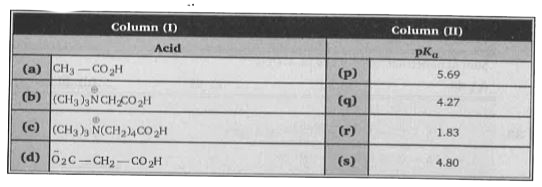
View SolutionMatch the column I and II.

View Solution
Sum of molecular mass of gas (A + C) is :
View Solution`Ph-overset(O)overset(||)C-O-Hoverset(NaHCO_3)rarr(A)` gas
`Ph - C-=CHoverset(Na)rarr(B)` gas
`Ph - OH overset(NaNH_2)rarr(C) ` gas
`R - O - H overset(NaH)rarr(D)` gas
Sum of molecular mass of gas (A + C) is :
View SolutionMatch the column I and II.

View SolutionConsider the following reaction of boron trifluoride `(BF_3)` and acetone:

What is the critical HOMO (nucleophile) of this reaction ?
View SolutionConsider the following reaction of boron trifluoride `(BF_3)` and acetone:

What is the critical LUMO (electrophile) of the reaction ?
View SolutionConsider the following reaction of boron trifluoride `(BF_3)` and acetone:

Which of the following is the correct product of this reaction ?
(Lone electron pairs are not shown explicitly).
View SolutionRank the following carbocations according to stability (1 = most stable, 5 = least stable).

Put the answer in the boxes.
View SolutionConsider the following reaction of boron trifluoride `(BF_3)` and acetone:

what is the critical HOMO (nucleophile) of this reaction?
View SolutionAmong the given pairs, which is more reactive towards `AgNO_3` (or) toward hydrolysis.


View SolutionPut the answer in boxes given as directed.

View SolutionCircle any conjugated portions of these molecules.

View SolutionArrange in the order as directed -
The given alkenes in the order of their stability (1- most stable, 3-least stable).

View SolutionArrange in the order as directed -
Arrange the following in the order of their acidic strength (1-most acidic, 4-least acidic)

View SolutionArrange in the order as directed -
Arrange the following molecules in order of expected boiling point. (1=highest bpt , 4=lowest bpt.)

View SolutionArrange in the order as directed -
Arrange the following alkenes in order of their stability. (1 = most stable, 5 = least stable).

View SolutionMatch the column. (Matrix)

View SolutionIdentify (+M) mesomeric & (-M) group of following.


View SolutionIdentify the following solvents as polar protic (PP), polar aprotic (PA), non-polar protic (NPP) or non-polar aprotic (NPA).

View SolutionIdentify the stronger nucleophile in each pair.

View SolutionAmong the hydrides of halogens
Which has lowest boiling point ?
View SolutionEncircle the molecule as directed :
Which has a higher boiling point : `CH_3 - CH_2 - CH_2 - CH_2 - CH_3` or `CH_3-underset(CH_3)underset(|)overset(CH_3)overset(|)(CH_2)-CH_3`
View SolutionEncircle the molecule as directed :
Which is more miscible with methanol `(CH_3OH) : CH_3 -CH_2 - CH_2 - CH_2 - CH_3` or `CH_3 - CH_2 - CH_2 - CH_2 - CH_2 - CH_3`
View SolutionEncircle the molecule as directed :
higher melting point : `CH_4` or `CH_3 - CH_2 - CH_3`
View SolutionEncircle the molecule as directed :
Which has a higher boiling point : `CH_3 - CH_2 - CH_2 - CH_2 - CH_3` or `CH_3-underset(CH_3)underset(|)overset(CH_3)overset(|)(CH_2)-CH_3`
View SolutionEncircle the molecule as directed :
Which is more stable : `BH_3` or `BF_3`
View SolutionEncircle the molecule as directed :
Which is a stronger base : `HO^(-)` or `H_2O`
View SolutionEncircle the molecule as directed :
Which is a stronger base : `HO^(-)` or `HS^(-)`
View SolutionHF is a weak acid but HCl is a strong acid because
View SolutionEncircle the molecule as directed :
Which is a stronger acid : HOCI or HCI
View SolutionExplain why A has lower boiling point than B ?

View SolutionArrange the protons shown in the decreasing order of their approximate bond energies.

View SolutionConsider the H-atoms in the molecule given below and answer the following.

Identify the type (`1^@, 2^@` or `3^@` alkyl, vinyl, allyl etc.) of these H-atoms.
View SolutionConsider the H-atoms in the molecule given below and answer the following.

Arrange them in the decreasing order of their case of abstraction (easiest first)
View SolutionConsider the molecule shown below and answer with respect to `H_a rarrH_e`

Identify the type of H-atom ( `1^@, 2^@, 3^@` alkyl, vinyl or allyl)
View SolutionConsider the molecule shown below and answer with respect to `H_a rarrH_e`
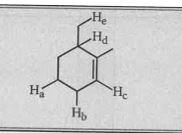
Arrange them in decreasing order of their bond energy.
View SolutionRank the following carbocations in order of stability (1 = most stable).

View SolutionRank the following alkenes according to energy (1 = lowest energy).

View SolutionMatch the column:

View Solution
LEVEL - 2 questions and complete solutions for chapter GENERAL ORGANIC CHEMISTRY of MS CHOUHAN of Class 12